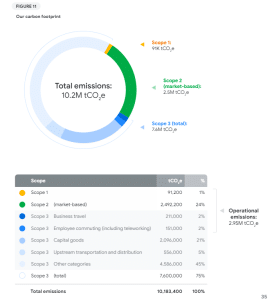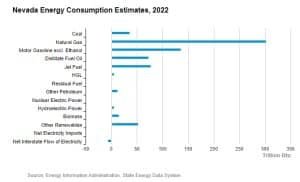Google’s Alphabet is advancing towards its zero-carbon goals by partnering with NV Energy, to supply its Nevada data centers with geothermal electricity. With this move, Google plans to inject 115 megawatts of carbon-free geothermal power over the next six years. However, the deal is pending approval from state utility regulators.
Let’s zoom in on the details here:
Google and NV Energy Amplify Clean Power 25x with CTT
From a regulatory perspective, Google’s partnership with Berkshire Hathaway’s electric utility, NV Energy is based on a “Clean Transition Tariff” (CTT) to procure 115MW of RE from a geothermal power plant operated by Fervo Energy.
Notably, Fervo Energy began a pilot program with Google in 2021 and is now set to significantly scale up its supply to meet Google’s growing demand for renewable power.
The company has been working with partners across the U.S. to create a scalable approach for utilities and large energy users to invest in clean firm capacity. They aim to speed up the commercial deployment of advanced clean technologies.
Most significantly, Google-NV energy deal will further enhance geothermal capacity by ~ 25 x.
This expansion brings more round-the-clock carbon-free energy to the local grid, supporting Google’s data center operations like AI and cloud computing in Nevada.
CCT Bolsters the Grid and Customers’ Confidence for a Sustainable Future
The Clean Transition Tariff (CTT) brings together utilities and customers in long-term energy agreements. Here’s how it can transition U.S. holistically to a sustainable future:
- Fosters investments in new projects that supply clean power to the grid. This, in turn, would amplify clean energy capacity and boost grid reliability.
- Allows customers to meet their rising power demands with 24/7 carbon-free energy.
- Customers gain long-term benefits of enhanced clean and reliable power through their existing utility connections.
Amanda Peterson Corio, Global Head of Data Center Energy, and Briana Kobor, Head of Energy Market Innovation at Google have expressed themselves in Google blog by noting,
“It’s not just Google that stands to benefit from this new model. If widely adopted across U.S. markets, the CTT structure can expand clean energy capacity and improve grid reliability, accelerate the roll-out of new technologies needed to enable clean industrial growth, and bring the economic benefits of clean energy to communities everywhere.”
The Rise of Revamped Procurement Models to Drive Energy Transition
Amanda and Briana have further revealed in their article that many companies secure clean energy, mainly wind and solar, through power purchase agreements (PPAs) with project developers. Google has been a leader in this successful model. Since 2008, corporate clean energy buyers have contributed nearly 200 GW of new solar and wind capacity globally.
However, they have highlighted the drawbacks of this method, like
- PPAs are often not integrated with broader grid planning and utility investment processes.
- Weather variability can lead to inconsistent availability of solar and wind energy.
Therefore, achieving fully decarbonized electricity systems necessitates technologies capable of providing clean power at any time, known as “clean firm capacity.” However, technology is still in its infancy primarily due to improper regulatory framework and huge cost factors. Consequently, customers are forced to depend on fossil fuels for consistent power when renewables are insufficient.
Thus, Google believes in taking full advantage of 24/7 carbon-free energy technologies. It is addressing the increasing demands of local grids with a streamlined approach to investing in clean energy projects that provide firm capacity.
Is Google’s CTT a Game-Changer for Clean Energy Investment?
Based on the confirmative statements made by Google officials, we can confidently say YES to this question.
Furthermore, Google claims that the CTT will enhance the clean energy transition by enabling companies like NV Energy to receive funds downright to invest in new technologies. Certainly, this is a unique approach and significantly different from traditional power purchase agreements (PPAs). Subsequently, helping Google offset its emissions.
In 2022, Google signed contracts for approximately 2.8 GW of clean energy generation capacity, the highest ever.
Google’s latest environmental report shows that 64% of its global operations use carbon-free energy such as wind and solar.
Below is the image of Google’s carbon footprint for 2022. It aims to reduce 50% of our
combined Scope 1, 2 (market-based), and 3 absolute GHG emissions before 2030.

The deal with NV Energy is a strategic move to increase this percentage, highlighting Google’s commitment to its clean energy goals. From media reports, we also discovered that Duke Energy has already partnered with Google and others to develop a similar CTT model in the Southeast United States.
Powering Nevada: NV Energy and Google Transform Clean Energy Access
In Nevada’s regulated power markets, companies struggle to source entirely clean energy directly from generators. This groundbreaking partnership tackles this challenge by integrating Google into NV Energy’s power generation with the help of CCT.
Doug Cannon, president and CEO of NV Energy has given a long statement on the prospects of this deal. He said,
“The partnership can develop new solutions to bring clean, firm energy technology — like enhanced geothermal — onto Nevada’s grid at this scale is remarkable. This innovative proposal will not be paid for by NV Energy’s other customers but will help ensure all our customers benefit from cleaner, greener energy resources. If approved, it provides a blueprint for other utilities and large customers in Nevada to accelerate clean energy goals.”
Nevada consumes 6X more energy than the state produces in part because Nevada produces only small amounts of natural gas and crude oil and does not mine any coal. Geothermal energy, which utilizes naturally occurring underground heat to generate electricity, holds considerable promise in Nevada.
According to US Energy Information and Administration (US EIA)
- In 2023, Nevada accounted for 26% of the nation’s utility-scale electricity generation from geothermal energy. Only California generated more.
- Geothermal resources contribute to about 10% of Nevada’s total electricity generation.
This pivotal agreement with NV Energy integrates advanced geothermal projects, delivering carbon-free electricity to power Google’s data centers. Google will keep partnering with utilities, regulators, and energy customers to drive clean energy investments, and advanced technologies, and build a robust, carbon-free grid.


